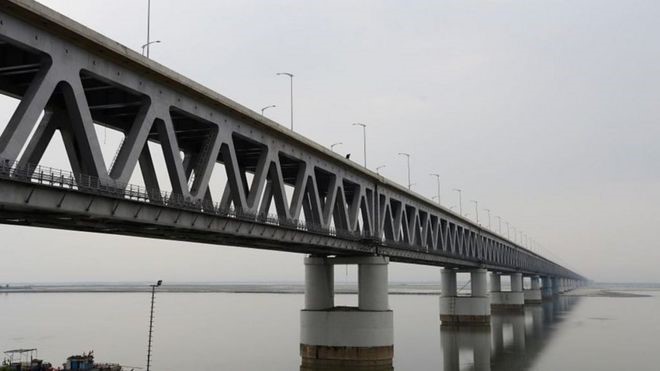Why does China want to build a tunnel under the Brahmaputra at the India border?
The severe floods in the Brahmaputra River in Assam have wreaked havoc. A large part of the country’s north-eastern state of Assam is vulnerable to this flood.
On the other hand, it is believed that the Government of India has given its approval in principle to the construction of a tunnel of about 15 km long inside the Brahmaputra River.
Through this tunnel, movement will be able to ensure uninterrupted movement to the China border.
The central and state ruling Bharatiya Janata Party has published information about the plan of this tunnel on 16 July.
BJP President of Assam Ranjit Kumar Das wrote in a tweet that getting in-principle approval from the central government for the construction of a four-lane tunnel under the Brahmaputra river is a landmark in terms of security and movement of Assam, North-East and India. Is the decision.
On the other hand, flood waters have caused great havoc in the large network of Brahmaputra and its tributaries. On 20 July, Assam Chief Minister Sarbananda Sonowal told the news agency ANI that in the last few days, at least 85 people have died due to this flood and about 7 million people have been affected.
The number of people affected and killed by this flood is more than that of the Kovid-19 epidemic.
According to the official data of 21 July, 25,382 people have been infected in Assam since Kovid-19, while 58 people have died.
Strategic importance
The Brahmaputra River originates from Tibet in China. It extends to India, Bhutan and Bangladesh and is spread over an area of 5,80,000 square kilometers.
It is counted among the five largest rivers of the world.
With a water discharge of 19,830 cubic meters per second from its mouth, the Brahmaputra’s number comes after Amazon, Congo and Yangtze.
It has a strategic importance in Northeast India. A navy of Ahom state, which ruled the region from 1228 to 1826, was stationed in this river which was deployed for protection from other enemies including the Mughal Empire.
In the battle of Saraighat of 1671, the Ahom Navy destroyed a huge army led by Ram Singh, the commander of Aurangzeb. And in this way the expansion of Mughals in this area was curbed.
Downstream tunnel?
The Brahmaputra, once the protector of the Ahom kingdom, is becoming a cause of concern for the planners of the Indian Army today, because of this river, the northern part of Assam and the entire northeastern part of Arunachal Pradesh are under threat of the Chinese army.
China has steadily strengthened its penetration in the entire region since the 1962 war.
India’s security system feels that Arunachal Pradesh and parts of Assam can be cut off from the rest of India with the power to attack the five existing bridges built on the Brahmaputra of the Chinese Army.
Now the 14.85 km long tunnel under this river will connect Sumaligarh on the southern side and Gohpur on the northern side. This will be an alternative route for civil and military movement.
The Indian Army had asked the government to consider building tunnels on the Brahmaputra river because the bridges built on this river could become the target of the enemy’s army.
Last year, it was reported last year that the Indian government is considering building a tunnel under the Brahmaputra river. The ET said in its April 2019 report that this tunnel would provide complete security to the movement of military convoys.
But, why now?
It is easy to get connected between the ongoing border dispute between India China and the approval for the tunnel.
However, under the leadership of Prime Minister Narendra Modi, the Indian government is already making war efforts in strengthening its infrastructure on the border compared to China.
The plan to construct an under-water tunnel can be seen in this link. The Hindustan Times has written in the news that the decision to build the tunnel was approved by the government in March itself, which was long before the atmosphere of tension created on the border with China.
India has increased spending on construction of roads along the border with China from $ 61.5 million in 2016 to $ 1.6 billion in 2020.
What is feedback?
The Indian government seems to be suppressing this incident. No government official has commented on the issue of the tunnel. Also, there has been no response from China on this issue.
There has been sporadic coverage on this issue in the national media of India, but there is a lot of discussion about it in Assam.
A July 17 editorial in Assamese daily, a leading Assamese language newspaper, alleged that the government only wants to make headlines by discussing under-water tunnels, while promising many other infrastructure projects yet to be ground realistically Has not been transformed
Social media users are also seen ridiculing the plans of tunneling every year due to millions of people affected in Assam floods and the government’s failure to stop it. Many mimes are also going on on social media. A Facebook user wrote, “There is no need to build a tunnel under the river. First strengthen the river banks so that the people of Assam can be saved from the floods.”




